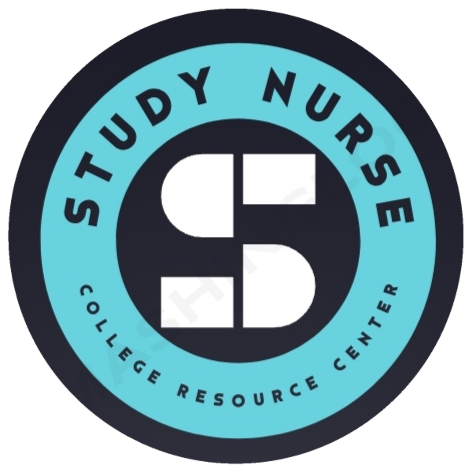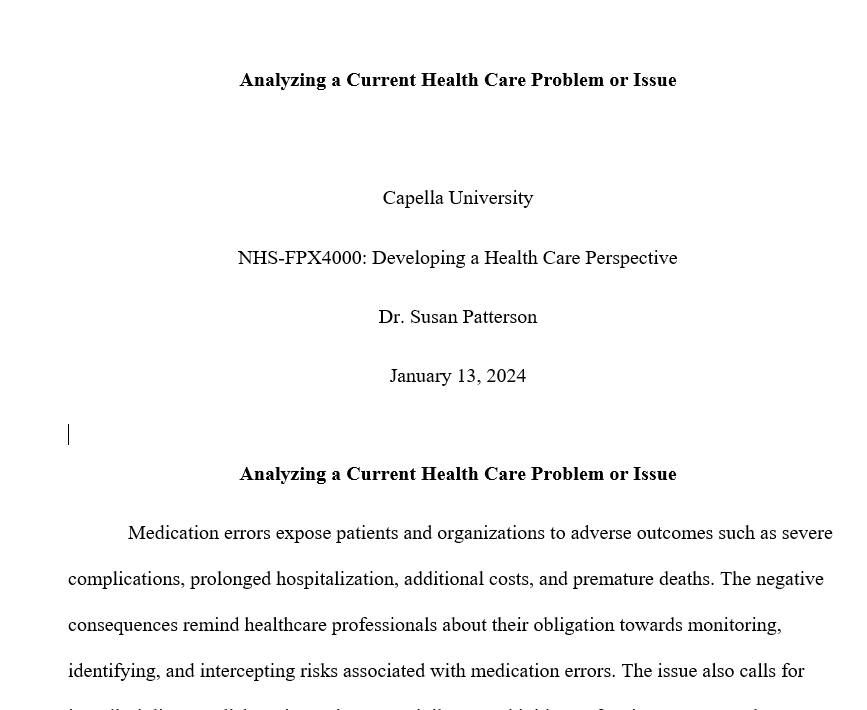Capella University
NHS-FPX4000: Developing a Health Care Perspective
Dr. Susan Patterson
January 13, 2024
Analyzing a Current Health Care Problem or Issue
Medication errors expose patients and organizations to adverse outcomes such as severe complications, prolonged hospitalization, additional costs, and premature deaths. The negative consequences remind healthcare professionals about their obligation towards monitoring, identifying, and intercepting risks associated with medication errors. The issue also calls for interdisciplinary collaboration to increase vigilance and initiate safety improvement plans appropriate for enhancing the quality and safety of patient care.
Medication Errors
Medication errors are among the most reported incidents in the healthcare system. The issue attracts attention from patients, families, the healthcare team, regulators, and other stakeholders responsible for ensuring consistent safety and quality of patient care. Marufu et al. (2022) defined medication errors as preventable outcomes caused by inappropriate medication preparation and administration and have the potential of causing patient harm. Repeated errors raise questions about the level of training, education, and adhering patient safety culture (Marufu et al., 2022). The other causes of medication errors include inadequate staffing, failure to embrace double-checking, limited knowledge on handling high-alert medications, and interruptions within the medication preparation or administration room.
Successful outcomes depend on nurses’ adherence to the rights of safe medication administration. The rights include the right time and drug in the right dose and by the right route. For this paper, a case that happened at Dorn VA Medical Center in South Carolina will provide insights into the causes, consequences, and solutions for medication errors. In the incident, a nurse repeatedly administered doses of pegfilgtastim instead of filgrastim (Sneed, 2019). The patient developed pulmonary toxicity, which escalated to severe acute lung injury and death. The case also resulted in $800,000 settlement, which showed the high cost of medication errors.
Analysis
The identified scenario captures patient’s vulnerability to wrong medication administration, severe complications, and premature deaths. A common reason for the error was the similar sounding medications that caused a selection mistake. In this case, the similar sounding drug names make it challenging for nurses, physicians, and pharmacists to ensure safe, correct, and effective administration of medications (Martyn et al., 2019). The incidence also revealed nurse negligence associated with failure to read warning signs, confirm a patient’s medication needs, and adhere to policies and procedures on safe medication administration. The negligent nurses are vulnerable to interruptions and disruptions from unrelated activities such as communicating with colleagues when preparing or administering medications.
Inadequate oversight is another challenge that jeopardizes ability to identify and intercept errors. The gap means that leaders such as nurse managers do not provide adequate instructions and follow-ups. Leaders fail to ensure adequate knowledge of high-alert medications and consistent adherence to policies, procedures, and practice standards (Martyn et al., 2019). Ethically, medication errors from administrative and human-related weaknesses highlight non-adherence to the principles of non-maleficence, beneficence, autonomy, and justice (Rizalar & Baltaci, 2020). For instance, negligence means reduced willingness to serve patient interests and prevent emotional, physical, and psychological harm from medication errors. Similarly, patients require adequate explanation of events leading to a medication errors and interventions adopted to prevent similar outcomes in the future.
Options for Addressing Medication Errors
Addressing medication errors requires a comprehensive framework characterized by adequate knowledge of administrative, technical, and human-related aspects. One primary consideration is adequate oversight when handling high-alert medications associated with adverse reactions, complexities, and premature deaths (Kaneko & Okada, 2018). The process requires leaders to monitor employees’ actions for consistent adherence to instructions and warnings. A second intervention is adequate training, education, and briefings to make everyone aware of standards for responding to similar sounding drugs (Kaneko & Okada, 2018). The training makes nurses, physicians, and pharmacists responsive to calls for maximum attention and understanding of the rights of safe medication administration.
Double-checks are other essential considerations that encourage physicians, nurses, and pharmacists to ascertain accuracy and adequacy of prescribed order. The process entails allowing a second nurse to verify medication details and ensure they match a patient’s treatment needs (Schutijser et al., 2019). In the end, patients receive the right medications, at the right time, and in the right dosage. Double-checks are also means of promoting adherence to the recommended safety culture characterized by collective vigilance across the care continuum. Effective labelling of similar sounding and look-alike medications is also vital to reduce selection errors and protect patients from potential harm.
Solution
Wrong medication administration is a serious threat to organization reputation and financial success. The incidents highlight the need for proactive interventions largely ones that encourage collective vigilance throughout the medication preparation and administration processes. Double-checking is the preferred solution that allows two or more qualified professionals, largely nurses to check and confirm accuracy of an order before administering to a patient (Berdot & Sabatier, 2018). The procedure facilitates verification of the dose, timing, diluents, and medication order. The goal is to identify and intercept errors and near misses before they cause harm to patients. Schutijser et al. (2019) reminded healthcare providers about the need for standard and judicious frameworks for implementing double-checking. Notably, the care team should use double-checks when taking medications out of a drawer and before administering to a patient. The advantage of the practice is that it reduces the risk of confirmation bias associated with the same patient preparing and checking medications.
Ethical Implications
Double checks makes nurses responsive to the principles of justice, beneficence, non-maleficence, and autonomy. Verifying medication order and ensuring alignment with the five rights of safe medication administration portrays the care team’s commitment to fulfilling a patient’s best interests (Salami et al., 2019). In this case, nurses’ decisions depend on reference to clients’ expectations. Similarly, nurses understand non-maleficence and the need to protect patients from physical, emotional, financial, and psychological distress (Rizalar & Baltaci, 2020). The nursing team overcomes negligence, disruptions, miscommunication, and other mismatches associated with medication administration errors. Increased awareness of safe medication administration also informs nurses about the value of delivering fair services. The team avoids decisions and negligent actions that deny patients access to honorable services across the continuum.
Implementation
The implementation involves training, education, and briefings on effective use of double-check checklists to confirm the accuracy of orders. The care team gets an opportunity to learn from a case study, participate in role-plays, and learn from educational sessions. The implementation also entails assembling an interdisciplinary team to promote collective commitment to increasing vigilance and intercepting risks associated with medication errors.
Conclusion
Wrong medication administration allows the care team to identify weaknesses within the clinical environment and interventions necessary to enhance the quality and safety of patient care. A case of a nurse administering doses of pegfilgtastim instead of filgrastim highlights the need for interventions such as safe staffing, allowing experienced nurses to handle high-alert medications, and double-checking. The aim is to encourage positive values, behaviors, and beliefs that reinforce consistent adherence to the rights of safe medication administration.
References
Berdot, S., & Sabatier, B. (2018). Medication errors may be reduced by double-checking method. Evidence-Based Nursing, 21, (3), 67-67. https://hal.archives-ouvertes.fr/hal-03335317/file/Berdot%20double%20check%202018.full.pdf
Kaneko, S., & Okada, M. (2018). Medication management factors associated with medication errors at Japanese long-term care facilities. Journal of Applied Medical Sciences, 7(1), 1-10. https://www.scienpress.com/Upload/JAMS/Vol%207_1_1.pdf
Martyn, J., Paliadelis, P., & Perry, C. (2019). The safe administration of medication: Nursing behaviors beyond the five-rights. Nurse Education in Practice, 37, 109-114. https://s1106788.stacksdiscovery.com/sites/default/files/safe%20med%20admin%20for%20112_0.pdf
Marufu, T., Bower, R., Hendron, E., & Manning, J. (2022). Nursing interventions to reduce medication errors in pediatrics and neonates: Systematic review and meta-analysis. Journal of Pediatric Nursing, 62, 139-147. https://www.pediatricnursing.org/action/showPdf?pii=S0882-5963%2821%2900257-8
Rizalar, S., & Baltaci, N. (2020). Ethical decision-making levels of nurses and it’s affecting factors. International Journal of Caring Sciences, 13(1), 42-50. https://www.internationaljournalofcaringsciences.org/docs/6_rizarlar_original_13_1.pdf
Salami, I., Subih, M., Darwish, R., Al-Jbarat, M., Saleh, Z., Maharmeh, M., Alasad, J. & Al-Amer, R. (2019). Medication administration errors. Journal of Nursing Care Quality, 34 (2), 7-12. https://pubmed.ncbi.nlm.nih.gov/29975215/
Schutijser, B.C.F.M., Jongerden, I.P., Klopotowska, J.E., Portegijs, S., Bruijne, M.C., & de, Wagner, C. (2019). Double-checking injectable medication administration: Does the protocol fit clinical practice? Safety Science, 118, 853-860. https://postprint.nivel.nl/PPpp7059.pdf
Sneed, J. (2019). $800,000 settlement from fatal drug mix-up at VA Hospital. https://www.abrahamwatkins.com/blog/2019/01/800000-settlement-from-fatal-drug-mix-up-at-va-hospital/

